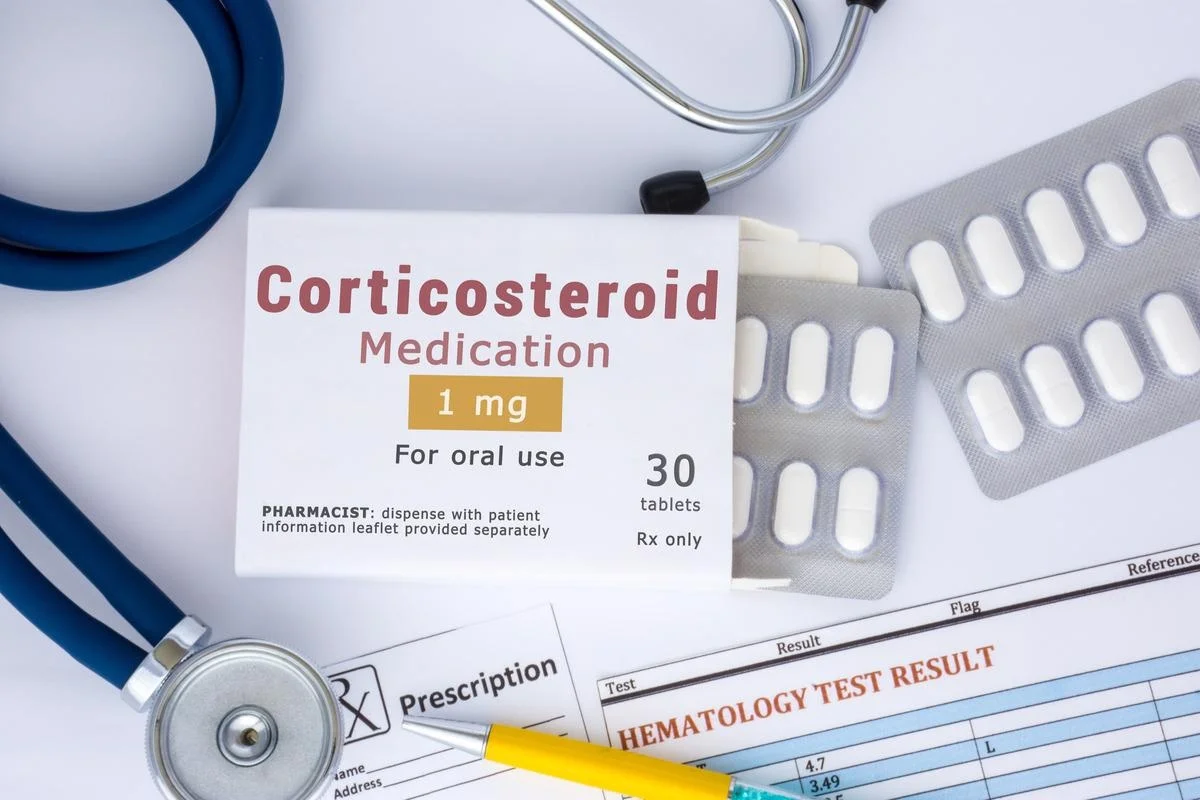Corticosteroids are a class of steroid hormones that are produced in the adrenal cortex of vertebrates. They play a vital role in various bodily functions ranging from regulating metabolism and immune responses to maintaining fluid balance. These compounds fall into two main categories: glucocorticoids and mineralocorticoids. Glucocorticoids, such as cortisol, are primarily involved in the stress response and have potent anti-inflammatory and immunosuppressive properties. Mineralocorticoids, like aldosterone, help control blood pressure and the balance of salt and water in the body.
Medical applications of corticosteroids are diverse and have revolutionized the treatment of numerous conditions. Due to their potent anti-inflammatory effects, glucocorticoids are commonly used to treat diseases such as asthma, rheumatoid arthritis, and various skin conditions. Mineralocorticoids are used in the management of conditions like Addison’s disease, where the body does not produce enough steroid hormones. These medications can be administered through various routes, including oral, injectable, topical, and inhaled, depending on the desired effect and the condition being treated.
Whilst corticosteroids are highly effective, they are not devoid of risks and side effects. Long-term use can lead to complications such as osteoporosis, weight gain, and an increased risk of infection. Physicians must consider these factors, especially in special populations such as pregnant women or the elderly, to ensure the benefits of corticosteroid therapy outweigh the potential risks.
Quick Summary
- Corticosteroids are vital steroid hormones with two main types, glucocorticoids and mineralocorticoids.
- They have broad medical applications, including anti-inflammatory and immunosuppressive effects.
- Their administration requires careful consideration due to potential side effects and risks.
Types of Corticosteroids

Corticosteroids are a class of steroid hormones that are produced in the adrenal cortex. They are categorized into glucocorticoids and mineralocorticoids based on their physiological effects. Additionally, synthetic derivatives have been developed to target specific needs.
Glucocorticoids
Glucocorticoids are involved in the metabolism of carbohydrates, proteins, and fats and have potent anti-inflammatory effects. Cortisone and hydrocortisone are natural forms, with hydrocortisone being equivalent to the human hormone cortisol. In the realm of synthetic glucocorticoids, prednisone is converted by the liver into prednisolone, which then exerts its therapeutic actions. Dexamethasone is a more potent synthetic glucocorticoid with minimal mineralocorticoid effects.
Mineralocorticoids
Mineralocorticoids primarily affect electrolyte and water balance in the body. They do not have significant anti-inflammatory properties. Aldosterone is the primary natural mineralocorticoid, which plays a crucial role in regulating sodium and potassium levels. There are no notable synthetic mineralocorticoids represented among the mentioned entities.
Synthetic Derivatives
Synthetic corticosteroids are developed to enhance their desirable properties and reduce side effects. For instance, prednisolone is designed to exhibit greater anti-inflammatory effectiveness than its precursor prednisone. Dexamethasone is tailored for scenarios requiring high glucocorticoid activity without substantial mineralocorticoid effect, making it suitable for conditions like cerebral edema and croup.
References
Mechanisms of Action

Corticosteroids exert their effects by interacting with the glucocorticoid receptor and modulating both the inflammatory response and the immune system.
Anti-Inflammatory Effects
When corticosteroids bind to glucocorticoid receptors, they reduce inflammation by decreasing the production of pro-inflammatory cytokines and mediators. They stimulate the adrenal cortex to release anti-inflammatory proteins while inhibiting phospholipase A2, an enzyme critical for the synthesis of inflammatory molecules like prostaglandins and leukotrienes.
Immunosuppressive Properties
These substances also dampen the immune system by affecting leukocyte distribution and function. They cause a notable decrease in the number of circulating lymphocytes, eosinophils, and monocytes, leading to an overall immunosuppressive effect. This impairs the immune system’s ability to initiate and sustain an immune response.
References
Routes of Administration

Corticosteroids can be administered in several forms, depending on the condition being treated and the desired effect. They may be taken orally, applied topically, or given via injection or other parenteral methods.
Oral Administration
Oral corticosteroids are typically available in the form of capsules or tablets. This method is used when a systemic effect is needed, affecting the entire body. Oral corticosteroids are commonly prescribed for conditions like rheumatoid arthritis, lupus, and asthma.
Topical Application
For conditions affecting the skin, creams and ointments containing corticosteroids are applied directly to the affected area. Topical corticosteroids are beneficial for treating eczema, psoriasis, and dermatitis. Additionally, eye drops containing corticosteroids can be used for inflammatory eye conditions.
Injections and Parenteral
Corticosteroids can also be administered through injections directly into affected joints, muscles, or lesions. This parenteral route delivers the medication quickly and to a specific location. Another parenteral method includes inhaled corticosteroids which are essential in managing chronic respiratory conditions such as asthma and chronic obstructive pulmonary disease (COPD).
References
Clinical Uses of Corticosteroids

Corticosteroids serve as pivotal treatments across a spectrum of medical conditions due to their potent anti-inflammatory and immunosuppressive properties.
Allergic Conditions
Corticosteroids are instrumental in managing severe allergic reactions and asthma exacerbations. They reduce inflammation and immune response that characterize allergies.
- Asthma: Inhaled corticosteroids are a mainstay therapy to prevent and control symptoms.
- Allergy: Systemic corticosteroids might be used for short-term relief of severe allergic symptoms.
Autoimmune Diseases
These diseases benefit from the immunomodulatory effects of corticosteroids, mitigating the abnormal immune response.
- Rheumatoid arthritis: Corticosteroids decrease joint inflammation and pain.
- Systemic lupus erythematosus (SLE): They are used to control flares and reduce immune system activity.
- Lupus: Management includes corticosteroids to control inflammation.
- Polymyalgia rheumatica: Relief of muscle pain and stiffness is achieved with corticosteroid treatment.
Pulmonary Disorders
Corticosteroids play a critical role in the management of chronic pulmonary conditions.
- Chronic Obstructive Pulmonary Disease (COPD): They help in reducing airway inflammation and exacerbations.
- Sarcoidosis: The anti-inflammatory action helps to manage granulomas and pulmonary symptoms.
Other Inflammatory Conditions
These are a collection of conditions where corticosteroids help by curbing the inflammatory cascade.
- Inflammatory bowel disease (IBD), which includes ulcerative colitis, often requires corticosteroids for acute flare-ups.
- Sarcoidosis: Beyond the lungs, corticosteroids can also treat systemic issues in sarcoidosis.
References
- https://www.ncbi.nlm.nih.gov/pmc/articles/PMC2921747/ – Role of corticosteroids in Asthma management.
- https://www.niams.nih.gov/health-topics/lupus – Understanding Lupus and corticosteroid use.
- https://www.ncbi.nlm.nih.gov/books/NBK532940/ – Corticosteroids in COPD.
Side Effects and Risks

Corticosteroids are powerful medications with significant medical applications. However, they carry a range of potential side effects and risks that differ depending on the duration of use.
Short-Term Complications
Short-term use of corticosteroids, generally for a few days or weeks, can lead to several immediate side effects which manifest rapidly after starting the medication. Users may experience:
- Elevated blood glucose levels leading to temporary hyperglycemia.
- Transient increases in blood pressure.
- Mood swings, including feelings of anxiety or depression.
Muscle weakness and bruising can also occur, even with brief use. Other acute side effects include weight gain, primarily due to fluid retention and increased appetite.
Long-Term Consequences
Extended use of corticosteroids, often defined as several weeks to months, can result in more serious and potentially irreversible conditions. These include but are not limited to:
- Osteoporosis, characterized by weakened bones and an increased risk of bone fractures.
- The development of diabetes due to persistent high blood sugar levels.
- High blood pressure (hypertension), with lasting cardiovascular implications.
Psychosis and other severe psychological effects emerge in some patients. The long-term physical effects may also encompass muscle weakness becoming more pronounced, leading to difficulties with everyday activities.
References
Considerations in Special Populations

When prescribing corticosteroids to special populations, healthcare providers must consider specific potential risks and adjust treatments accordingly to minimize adverse effects.
Pediatric Use
In pediatric patients, corticosteroids must be used with caution due to the potential for growth suppression and an increased risk of infections. Infections can be more severe in children on corticosteroids, making close monitoring imperative. Dosing recommendations often require careful titration to balance therapeutic benefits with the risk of growth inhibition.
Pregnancy and Lactation
Corticosteroids can cross the placenta and affect fetal development, potentially causing low birth weight and, in some cases, cleft palate. There is also a risk of gestational diabetes and hypertension in the mother. When used during lactation, the medication can be present in breast milk and may harm the nursing infant. Therefore, the decision to administer corticosteroids during pregnancy and lactation should be made with careful consideration of the benefits-to-risks ratio for both mother and child.
Elderly Patients
Elderly patients on corticosteroids are at an increased risk for glaucoma and cataracts. Blood pressure must be regularly monitored due to the risk of hypertension. These patients may also have a diminished immune response, which heightens the risk of infections. Dosage adjustments and regular eye exams are recommended for elderly patients receiving corticosteroid therapy to manage these risks effectively.
References
Frequently Asked Questions

In addressing queries about corticosteroids, it is significant to note their medical applications, side effects, and classification to better understand their role in treatment.
What are the common side effects associated with the use of corticosteroids?
The use of corticosteroids can lead to side effects such as increased blood sugar levels, susceptibility to infection, osteoporosis, and changes in mood and behavior. Long-term use may cause Cushing’s syndrome, characterized by a fatty hump between the shoulders, a rounded face, and pink or purple stretch marks.
What medical conditions are treated with corticosteroids?
Corticosteroids are used in treating a myriad of conditions including asthma, rheumatoid arthritis, lupus, and other autoimmune diseases. They are also instrumental in managing inflammatory diseases and are used in cancer therapies to alleviate swelling and prevent nausea during chemotherapy.
How are corticosteroids classified and what distinguishes each class?
Corticosteroids are classified into glucocorticoids and mineralocorticoids. Glucocorticoids, like prednisone, are primarily used for their anti-inflammatory and immunosuppressive properties, whereas mineralocorticoids, such as fludrocortisone, are used to manage electrolyte and fluid balance in the body.
Can you list some corticosteroid medications and their specific uses?
Examples of corticosteroid medications include prednisone, often prescribed for autoimmune conditions, and dexamethasone, used in high-altitude sickness and to treat certain forms of cancer. Hydrocortisone creams and ointments are used for skin conditions, while inhalable forms like budesonide treat respiratory conditions.
What are the main contraindications for the use of corticosteroids?
Corticosteroids should not be used by individuals with systemic fungal infections or those who have had a hypersensitivity reaction to the drug. Contraindications also include patients with untreated active or latent tuberculosis or ocular herpes simplex due to the potential worsening of these conditions.
How do the functions of various corticosteroids differ in medical treatments?
Different corticosteroids have varying potencies, durations of action, and receptor affinity profiles, which makes them suitable for different treatments. For example, methylprednisolone is often used for acute spinal cord injuries, while hydrocortisone is preferred for its mineralocorticoid activity in treating adrenal insufficiency.
References
https://www.mayoclinic.org/steroids/art-20045692
https://www.ncbi.nlm.nih.gov/books/NBK279156/
https://my.clevelandclinic.org/health/drugs/4812-corticosteroids
Dr. Grant Fourie, a specialist in male hormones, is based in Cape Town, South Africa. He provides comprehensive treatments for conditions related to low testosterone, such as erectile dysfunction, fatigue, and mood changes. His methods include hormone replacement therapy and other modern treatment options.
Contact me via email or phone to book personal appointment in my clinic: The Village Square, Cape Town - South Africa



